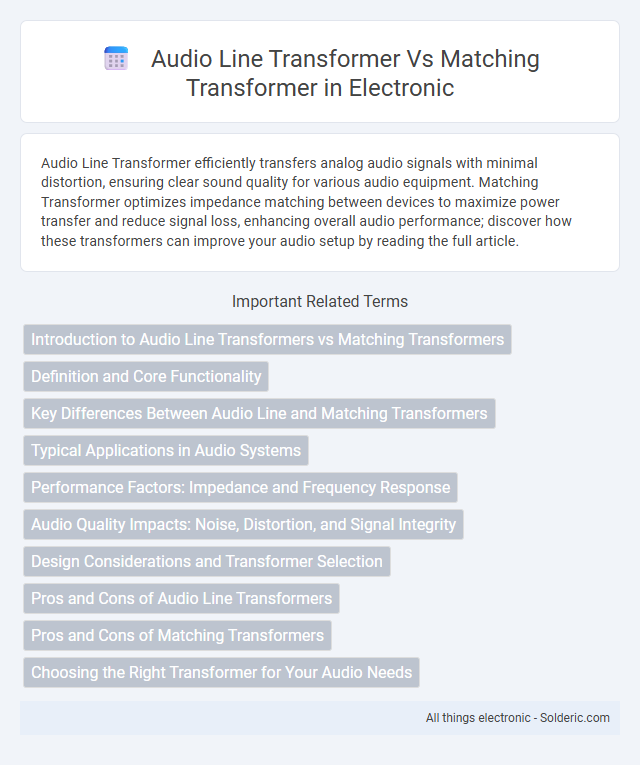Audio Line Transformer efficiently transfers analog audio signals with minimal distortion, ensuring clear sound quality for various audio equipment. Matching Transformer optimizes impedance matching between devices to maximize power transfer and reduce signal loss, enhancing overall audio performance; discover how these transformers can improve your audio setup by reading the full article.
Comparison Table
| Feature | Audio Line Transformer | Matching Transformer |
|---|---|---|
| Purpose | Transforms audio signals for transmission and processing. | Optimizes impedance matching in transformer circuits. |
| Application | Used in audio equipment, mixers, amplifiers. | Used in RF circuits, audio systems for signal integrity. |
| Frequency Range | Wide audio frequency range (20 Hz - 20 kHz). | Typically broader, often including RF and audio frequencies. |
| Function | Balances and isolates audio lines, reduces noise. | Matches impedance between source and load to minimize reflection and loss. |
| Design Focus | Low distortion, high fidelity audio transfer. | Impedance ratio optimization, minimal signal loss. |
| Common Configurations | 1:1 or 1:2 turns ratio for audio line balance. | Various turns ratios depending on required impedance matching. |
Introduction to Audio Line Transformers vs Matching Transformers
Audio line transformers are designed primarily for audio signal applications, providing impedance matching, isolation, and noise reduction in audio circuits. Matching transformers focus on matching impedance between different electrical components or transmission lines to maximize power transfer and minimize signal reflection across a broader frequency range. Each transformer type optimizes performance for specific use cases, with audio line transformers specialized for audio frequency signals and matching transformers suited for various impedance matching tasks in RF, telecommunications, and audio systems.
Definition and Core Functionality
An audio line transformer is designed to convert and isolate audio signals, providing impedance matching and noise reduction between audio equipment, ensuring clean signal transfer with minimal distortion. A matching transformer specifically adjusts impedance levels between different audio devices to maximize power transfer and prevent signal loss within the audio path. Both transformers play crucial roles in maintaining optimal audio quality, but the audio line transformer emphasizes isolation and signal cleanliness, while the matching transformer focuses primarily on impedance compatibility.
Key Differences Between Audio Line and Matching Transformers
Audio line transformers are primarily designed for impedance matching and noise isolation in low-level audio signals, often featuring broad frequency response and low distortion. Matching transformers focus on optimizing power transfer between devices with different impedance levels, emphasizing minimal signal loss and frequency flatness across a wide audio spectrum. Key differences include their intended application--audio line transformers for signal integrity in balanced lines and matching transformers for efficient impedance conversion--and their design priorities around frequency response and power handling capacity.
Typical Applications in Audio Systems
Audio line transformers are typically used in analog audio systems for impedance matching, signal isolation, and noise reduction in professional studio equipment and public address systems. Matching transformers, often found in audio interfaces and speaker systems, ensure optimal power transfer by matching the impedance between audio sources and load devices. Both types enhance audio signal quality but serve distinct roles depending on system architecture and application requirements.
Performance Factors: Impedance and Frequency Response
Audio line transformers and matching transformers differ significantly in impedance handling and frequency response characteristics. Line transformers typically focus on maintaining consistent impedance over a wide frequency range, providing minimal signal loss and distortion for balanced audio lines. Matching transformers are optimized for impedance conversion between different equipment, often prioritizing precise impedance ratios to ensure maximum power transfer while maintaining a controlled frequency response to minimize phase shifts and frequency attenuation.
Audio Quality Impacts: Noise, Distortion, and Signal Integrity
Audio line transformers typically provide superior noise isolation and reduce distortion by effectively balancing and isolating signals, enhancing overall signal integrity. Matching transformers primarily focus on impedance matching, which can minimize signal reflection and loss but may introduce slight distortion if not properly designed. Choosing the right transformer directly impacts your audio quality by maintaining clean signals and preserving the original sound fidelity.
Design Considerations and Transformer Selection
Audio line transformers are designed primarily for impedance matching and noise isolation in audio signal paths, focusing on maintaining signal integrity with low distortion and a flat frequency response across the audible spectrum. Matching transformers emphasize precise impedance matching between different circuit elements, often incorporating specific winding ratios and core materials to optimize frequency response and minimize insertion loss. Selecting the appropriate transformer requires evaluating key design considerations such as impedance levels, frequency range, insertion loss, and the presence of electromagnetic interference to ensure the transformer fulfills the audio system's performance and compatibility requirements.
Pros and Cons of Audio Line Transformers
Audio line transformers provide superior galvanic isolation and excellent impedance matching, reducing ground loop hum and noise in audio systems. However, they can introduce phase distortion and frequency response limitations, especially at extreme low and high frequencies. Your choice depends on whether isolation and noise reduction outweigh the potential impact on audio fidelity compared to simpler matching transformers.
Pros and Cons of Matching Transformers
Matching transformers optimize impedance matching between different audio components, minimizing signal loss and preserving audio fidelity for Your sound system. Pros include improved sound clarity, reduced noise, and compatibility with varying input/output impedances, while cons involve potential size and cost increases compared to simpler audio line transformers. Choosing a matching transformer depends on balancing enhanced performance with budget and installation constraints.
Choosing the Right Transformer for Your Audio Needs
Audio line transformers emphasize impedance matching and signal integrity in professional audio equipment, providing balanced audio connections and noise reduction for optimal sound quality. Matching transformers specialize in voltage and impedance adaptation between disparate audio components, ensuring compatibility and preventing signal loss or distortion. Selecting the right transformer depends on your specific application requirements, such as signal level, load impedance, and noise performance, to achieve the best audio fidelity and equipment interoperability.
audio line transformer vs matching transformer Infographic

 solderic.com
solderic.com